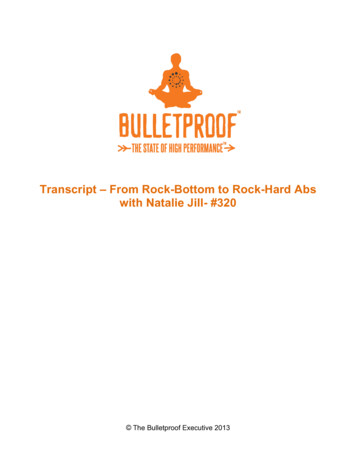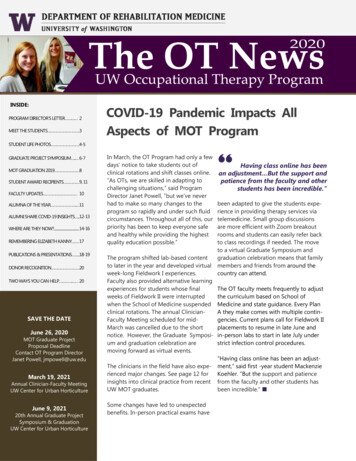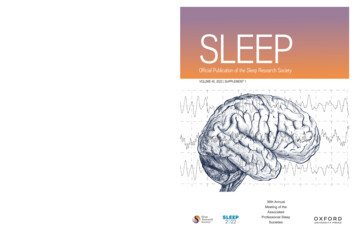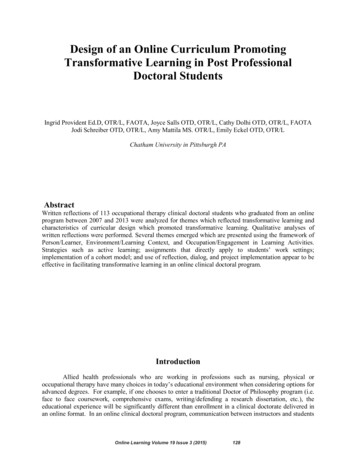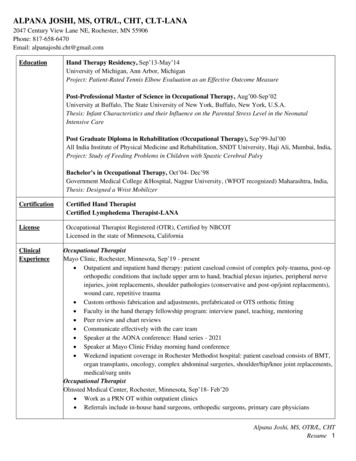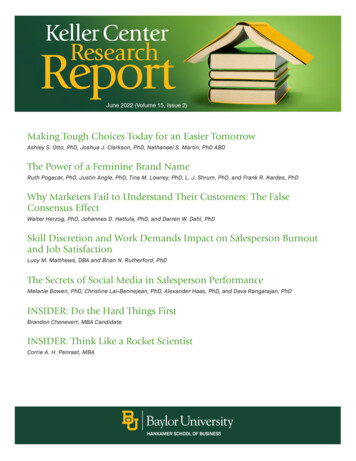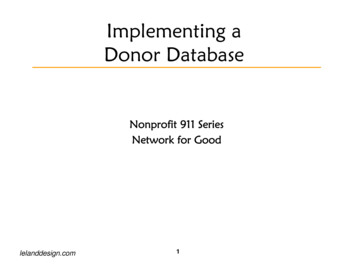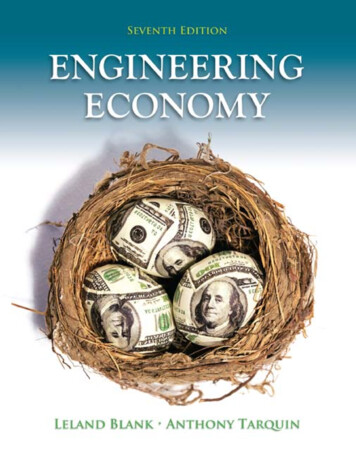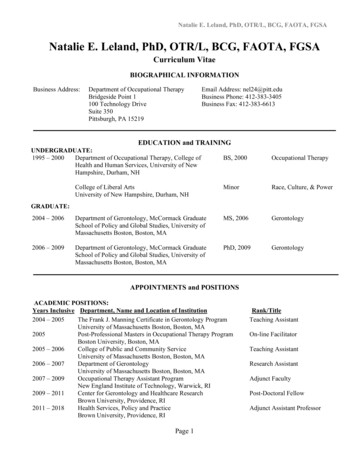
Transcription
Natalie E. Leland, PhD, OTR/L, BCG, FAOTA, FGSANatalie E. Leland, PhD, OTR/L, BCG, FAOTA, FGSACurriculum VitaeBIOGRAPHICAL INFORMATIONBusiness Address:Department of Occupational TherapyBridgeside Point 1100 Technology DriveSuite 350Pittsburgh, PA 15219Email Address: nel24@pitt.eduBusiness Phone: 412-383-3405Business Fax: 412-383-6613EDUCATION and TRAININGUNDERGRADUATE:1995 – 2000Department of Occupational Therapy, College ofHealth and Human Services, University of NewHampshire, Durham, NHBS, 2000Occupational TherapyCollege of Liberal ArtsUniversity of New Hampshire, Durham, NHMinorRace, Culture, & Power2004 – 2006Department of Gerontology, McCormack GraduateSchool of Policy and Global Studies, University ofMassachusetts Boston, Boston, MAMS, 2006Gerontology2006 – 2009Department of Gerontology, McCormack GraduateSchool of Policy and Global Studies, University ofMassachusetts Boston, Boston, MAPhD, 2009GerontologyGRADUATE:APPOINTMENTS and POSITIONSACADEMIC POSITIONS:Years Inclusive Department, Name and Location of Institution2004 – 2005The Frank J. Manning Certificate in Gerontology ProgramUniversity of Massachusetts Boston, Boston, MA2005Post-Professional Masters in Occupational Therapy ProgramBoston University, Boston, MA2005 – 2006College of Public and Community ServiceUniversity of Massachusetts Boston, Boston, MA2006 – 2007Department of GerontologyUniversity of Massachusetts Boston, Boston, MA2007 – 2009Occupational Therapy Assistant ProgramNew England Institute of Technology, Warwick, RI2009 – 2011Center for Gerontology and Healthcare ResearchBrown University, Providence, RI2011 – 2018Health Services, Policy and PracticeBrown University, Providence, RIPage 1Rank/TitleTeaching AssistantOn-line FacilitatorTeaching AssistantResearch AssistantAdjunct FacultyPost-Doctoral FellowAdjunct Assistant Professor
Natalie E. Leland, PhD, OTR/L, BCG, FAOTA, FGSA2011 – 201720132017 – 20172018 – present2019 – presentChan Division of Occupational Science and OccupationalTherapyUniversity of Southern California, Los Angeles, CACenter for Rehabilitation Research Using Large DatasetsUniversity of Texas Medical Branch, Galveston, TXChan Division of Occupational Science and OccupationalTherapyUniversity of Southern California, Los Angeles, CADepartment of Occupational Therapy, School of Health andRehabilitation SciencesUniversity of Pittsburgh, Pittsburgh, PADepartment of Occupational Therapy, School of Health andRehabilitation SciencesUniversity of Pittsburgh, Pittsburgh, PAACADEMIC APPOINTMENTSYears Inclusive Department, Name and Location of Institution2011 – 2017Davis School of Gerontology, University of SouthernCalifornia, Los Angeles, CA2017 – 2017Leonard D. Schaeffer Center for Health Policy & EconomicsUniversity of Southern California, Los Angeles, CA2018 – presentDepartment of Occupational Therapy, School of Health andRehabilitation Sciences, University of Pittsburgh, Pittsburgh,PA2020 – presentClinical and Translational Science Institute, School ofMedicine, University of Pittsburgh, Pittsburgh, PANON-ACADEMIC POSITIONS:2000 – 2000Slater Health CenterPawtucket, RI2000 – 2011Genesis Rehabilitation ServicesRhode Island, Massachusetts, Virginia2002 – 2003Medical Facilities of AmericaFairfax, Virginia2004 – 2005Haven HealthcareWarren, Rhode Island2005 – 2007Kindred Health CareFall River, Massachusetts2005 – 2007Sundance Rehabilitation CorporationMiddletown, Rhode IslandAssistant ProfessorVisiting ScholarAssociate Professor with TenureAssociate ProfessorVice Chair of ResearchRank/TitleSecondary AppointmentAffiliated Faculty MemberGraduate FacultySecondary AppointmentStaff TherapistStaff TherapistPRN Staff TherapistPRN Staff TherapistPRN Staff TherapistPRN Staff TherapistCERTIFICATION AND LICENSUREPROFESSIONAL CERTIFICATION:National Board for Certification in Occupational Therapy, #1044399American Occupational Therapy Association, Board Certification in GerontologyPROFESSIONAL LICENSURE:State of Rhode Island Occupational Therapy License, #OT00776Page 22000 – present2007 – present2000 – present
Natalie E. Leland, PhD, OTR/L, BCG, FAOTA, FGSAState of Massachusetts Occupational Therapy License, #7833State of Virginia Occupational Therapy License, #0119003402State of California Occupational Therapy License, #12540State of Pennsylvania Occupational Therapy License, #OC0159982001 – present2002 – present2012 – present2018 – presentMEMBERSHIPS in PROFESSIONAL and SCIENTIFIC SOCIETIESAcademy Health (AH), membership # 254604American Congress of Rehabilitation Medicine (ACRM), membership # 011730American Occupational Therapy Association (AOTA), membership # 60109Gerontological Society of America (GSA), membership # 1105925Occupational Therapy Association of California, membership # 1776790Pennsylvania Occupational Therapy Association, membership # 533274772009 – present2012 – 20191996 – present2004 – present2011 – 20192018 – presentHONORS & AWARDSACADEMIC HONORS:Occupational Therapy Department’s England Student Honor Award, University of NewHampshireAlpha Epsilon Delta, the National Health Pre-Professional Honor SocietySigma Phi Omega (SPO), the National Academic Honor and Professional Society in Gerontology199819992006COMPETITVE FELLOWSHIPS:Post-Doctoral Fellowship, National Research Service Award, Agency for Healthcare Research and 2009 – 2011QualityRESEARCH AWARDS:Health Science Person-in-Training Award, Gerontological Society of AmericaDissertation Book Award, Department of Gerontology, University of MassachusettsMid-Career Research Award, American Occupational Therapy FoundationSERVICE AWARDS:AOTA Board Certification in Geriatrics Panel Member, American Occupational TherapyAssociation Service CommendationAOTA Affiliated State Association President (Rhode Island), American Occupational TherapyAssociation Service CommendationAOTA Quality of Care Advisor, American Occupational Therapy Association ServiceCommendationAOTA Advisor, Primary Health Care – Falls Protocol, American Occupational TherapyAssociation Service CommendationAOTA Advisor, Quality Issues, American Occupational Therapy Association ServiceCommendationAOTA Advisor, Skilled Nursing Facility Workgroup, American Occupational TherapyAssociation Service CommendationAOTA Advisor, Quality Advisor Group, American Occupational Therapy Association ServiceCommendationAOTA Advisor, Skilled Nursing Facility Policy, American Occupational Therapy AssociationService CommendationPage 320072009201820092011201620172017201720182018
Natalie E. Leland, PhD, OTR/L, BCG, FAOTA, FGSAAOTA Advisor, Quality Advisor Group, American Occupational Therapy Association ServiceCommendationAOTA Advisor, Skilled Nursing Facility Policy, American Occupational Therapy AssociationService CommendationAOTA Advisor, Quality Advisor Group, American Occupational Therapy Association ServiceCommendationAOTA Advisor, Skilled Nursing Facility Policy, American Occupational Therapy AssociationService CommendationAOTA Advisor, Quality Advisor Group, American Occupational Therapy Association ServiceCommendationAOTA Advisor, Skilled Nursing Facility Policy, American Occupational Therapy AssociationService CommendationAOTA Advisor, Payment Policy, American Occupational Therapy Association ServiceCommendationPROFESSIONAL RECOGNITION:Roster of Fellows, AOTA, Excellence in Gerontological Research and LeadershipLindy Boggs Award for “Promoting Occupational Therapy Through Leadership in MedicarePolicy,” American Occupational Therapy AssociationFellow, Gerontological Society of LICATIONSPEER-REVIEWED MANUSCRIPTSHEALTH SERVICES/ TEAM SCIENCE PRODUCTS(†First Author, Senior Author)1. Steinman B, Nguyen AQ, Leland NE, Pynoos J. (2011). Falls-prevention interventions for personswho are blind or visually impaired. INSIGHT: Research and Practice in Visual Impairment andBlindness, 4, 83-91. Journal Impact Factor 0.33; Number of Citations 222. †Leland NE, Porell F, Murphy SL. (2011). Does fall history influence residential adjustments? TheGerontologist, 51,190-200. doi: 10.1093/geront/gnq086. Journal Impact Factor 5.271; Number ofCitations 163. †Leland NE, Teno J, Gozalo PL, Bynum J, Mor V. (2012). Decision making and outcomes ofhospice patient hospitalized with a hip fracture. Journal of Pain and Symptom Management, 44(3),458-465. doi: 10.1016/j.jpainsymman.2011.09.011. Journal Impact Factor 3.612; Number ofCitations 104. †Leland NE, Gozalo PL, Teno J, Mor V. (2012). Falls in newly admitted nursing home residents: Anational study. Journal of the American Geriatric Society, 60(5), 939-945. doi: 10.1111/j.15325415.2012.03931.x. Journal Impact Factor 5.562; Number of Citations 635. Elliott S, Ivanescu A, Leland NE, Fogo J, Painter J, Trujillo L. (2012). Feasibility ofinterdisciplinary community-based fall risk screening. The American Journal of OccupationalTherapy, 66, 161–168. doi: 10-5014/ajot.2012.002444. Journal Impact Factor 2.246; Number ofCitations 266. †Leland NE, Elliott S, O’Malley L, Murphy SL. (2012). Occupational therapy in fall prevention:Current evidence and future directions. The American Journal of Occupational Therapy, 66(2), 149–160. doi: 10.5014/ajot.2012.002733. Journal Impact Factor 2.246; Number of Citations 62Page 4
Natalie E. Leland, PhD, OTR/L, BCG, FAOTA, FGSA7. Tyler DA, Feng Z, Leland NE, Gozalo P, Intrator O, Mor V. (2013). Trends in post-acute care andstaffing in US nursing homes, 2001-2010. Journal of the American Medical Directors Association,14(11), 817-820. doi: 10.1016/j.jamda.2013.05.013. Journal Impact Factor 4.669; Number ofCitations 458. Teno JM, Gozalo PL, Bynum JW, Leland NE, Miller SC, Morden NE, Scupp T, Goodman D, MorV. (2013). Change in end-of-life care for Medicare beneficiaries: Site of death, place of care, andhealth care transitions in 2000, 2005, and 2009. Journal of the American Medical Association, 309,470-477. doi: 10.1001/jama.2012.207624. Journal Impact Factor 56.724; Number of Citations 9789. Mallinson T, Schepens Niemiec SL, Carlson M, Leland NE, Vigen C, Blanchard J, Clark F. (2014).Development and validation of the Activity Significance Personal Evaluation (ASPEn) Scale.Australian Occupational Therapy Journal, 61(6), 384-93. doi: 10.1111/1440-1630.12155. JournalImpact Factor 1.856; Number of Citations 210. †Leland NE, Marcione N, Schepens Niemiec SL,Kelkar K, Folgelberg D. (2014). What isoccupational therapy’s role in addressing sleep problems among older adults? Occupational TherapyJournal of Research: Occupation, Participation and Health, 34(3), 141-149. doi: 10.3928/1539449220140513-01. Journal Impact Factor 1.786; Number of Citations 3611. Gozalo PL, Leland NE, Christian TJ, Teno J, Mor V. (2015). Volume matters: Returning home afterhip fracture. The Journal of the American Geriatric Society, 63(10), 2043-51. doi:10.1111/jgs.13677. Journal Impact Factor 5.562; Number of Citations 3412. Martinez J, Leland NE. (2015). Language discordance and patient-centered care in occupationaltherapy: A case study. Occupational Therapy Journal of Research: Occupation, Participation andHealth, 35(2), 120-128. doi: 10.1177/1539449215575265. Journal Impact Factor 1.768; Number ofCitations 1113. Mallinson TR, Leland NE. (2015). The need for uniform quality reporting across post-acute carerehabilitation settings: An examination of accidental falls. The Journal of the American GeriatricSociety, 63(1), 195-7. doi: 10.1111/jgs.13221. Journal Impact Factor 5.562; Number of Citations 414. †Leland NE, Gozalo PL, Bynum J, Mor V, Wetle T, Teno JM. (2015). An examination of the first30 days after patients are discharged to the community from hip fracture post acute care. MedicalCare, 53(10), 879-87. doi: 0.1097/MLR.0000000000000419. Journal Impact Factor 2.983; Numberof Citations 3915. †Leland NE, Gozalo PL, Bynum J, Mor V, Teno JM. (2015). What happens to patients when theyfracture their hip during a skilled nursing facility stay? Journal of the American Medical DirectorsAssociation, 16(9), 767-74. doi: 10.1016/j.jamda.2015.03.026. Journal Impact Factor 4.669; Numberof Citations 1616. Lepore M, Leland NE. (2015). Nursing homes that increased the proportion of Medicare days sawgains in quality outcomes for long-stay residents. Health Affairs, 34(12), 2121-8. doi:10.1377/hlthaff.2015.0303. Journal Impact Factor 6.301; Number of Citations 1517. †Leland NE, Fogelberg D, Sleight A, Mallinson T, Vigen C, Blanchard J, Carlson M, Clark F.(2016). Napping and nighttime sleep: Findings from an occupation-based intervention. The AmericanJournal of Occupational Therapy, 70(4),7004270010. doi: 10.5014/ajot.2016.017657. Journal ImpactFactor 2.246; Number of Citations 2118. Fogelberg DJ, Leland NE, Blanchard J, Rich TJ, Clark FA. (2017). Qualitative experience of sleepin individuals with spinal cord injury. OTJR: Occupation, Participation and Health, 37(2), 89-97.doi: 10.1177/1539449217691978. Journal Impact Factor 1.768; Number of Citations 919. †Leland NE, Lepore M, Wong C, Chang SH, Freeman L, Crum K, Gillies H, Nash P. (2018).Delivering high quality hip fracture rehabilitation: The perspective of occupational and physicaltherapy practitioners. Disability and Rehabilitation, 40(6), 646-654. doi:10.1080/09638288.2016.1273973. Journal Impact Factor 3.033; Number of Citations 14Page 5
Natalie E. Leland, PhD, OTR/L, BCG, FAOTA, FGSA20. Elliot S, Leland, NE. (2018). Occupational Therapy Fall Prevention Interventions for CommunityDwelling Older Adults: A Systematic Review. The American Journal of Occupational Therapy,72(4), 7204190040p1-7204190040p11. doi: 10.5014/ajot.2018.030494. Journal ImpactFactor 2.246; Number of Citations: 2421. †Leland NE, Roberts P, *DeSouza R, *Chang SH, *Shah K, Robinson M. (2019). Care transitionprocesses to achieve a successful community discharge after postacute care: A scoping review. TheAmerican Journal of Occupational Therapy, 73(1). Journal Impact Factor 2.246; Number ofCitations 522. Martinez J, Wong C, Piersol CP, Bieber D, Perry B, Leland NE. (2019). Stakeholder engagement inresearch: A scoping review of current evaluation methods. Journal of Comparative EffectivenessResearch, 8(15)1327-1341. doi.org/10.2217/cer-2019-0047 Journal Impact Factor 1.744; Numberof Citations 223. Cogan A, Weaver J, McHarg M, Leland NE, Davidson L, Mallinson T. (2020). Length of stay andrecovery rate influence patients’ functional outcomes in post-acute care after hip fracture surgery.JAMA Network Open, JAMA Netw Open. 9.19672. Journal Impact Factor 8.485; Number of Citations 824. Martinez J, Piersol CV, Terhorst L, Holloway S, Leland NE (2021). Evaluation of StakeholderEngagement: Iterative Stakeholder-centric Instrumentation Process (SCIP). Western Journal ofNursing Research.43(10)949-961. Doi:10.1177/01939459211004274; Journal ImpactFactor 1.967; Number of Citations 2825. Harper AE, Terhorst L, Moscirella M, Turner RL, Piersol CV, Leland NE. (2021). The experiences,priorities, and perceptions of informal caregivers of persons with dementia in nursing homes: Ascoping review. Dementia (London), 20(8):2746-2765. doi:10.1177/14713012211012606; JournalImpact Factor 4.148; Number of Citations 225. Prusynski P, Leland NE, Frogner BK, Liebbrand C, Mroz T. (2022). Therapy Staffing in SkilledNursing Facilities Declined after Implementation of the Patient Driven Payment Model. The Journalof the American Medical Directors Association. The Journal of the American Medical DirectorsAssociation. S1525-8610(21)00381-9. doi: 10.1016/j.jamda.2021.04.005. Epub ahead of print.PMID: 33965404. Journal Impact Factor 4.148; Number of Citations 226. Martinez J, Piersol CV, Lucas K, Leland NE (2022). Operationalizing Stakeholder EngagementThrough the Stakeholder-Centric Engagement Charter (SCEC). Journal of General InternalMedicine. https://doi.org/10.1007/s11606-021-07029-4. Journal Impact Factor 5.128; Number ofCitations 227. Leland NE, Lekovitch C, Martinez J, Rouch S, Harding P, Wong C. (2022). Optimizing post-acutecare patient safety: A scoping review of multifactorial fall prevention interventions. Journal ofApplied Gerontology. 2022 May 26:7334648221104375. doi: 10.1177/07334648221104375. Epubahead of print. PMID: 35618304.HEALTH POLICY PRODUCTS(†First Author, Senior Author)28. †Leland NE, Crum K, Phipps K, Roberts P, Gage B. (2015). Health Policy Perspectives: Advancingthe value and quality of occupational therapy in health service delivery. The American Journal ofOccupational Therapy, 69(1), 1-7. doi: 10.5014/ajot.2015.691001. Journal Impact Factor 2.246;Number of Citations 4229. Mroz T, Pitonyak J, Fogelberg D, Leland NE. (2015). Health policy perspectives: Clientcenteredness and health reform: Key issues for occupational therapy. American Journal ofOccupational Therapy, 69(5), 1-8. doi: 10.5014/ajot.2015.69500. Journal Impact Factor 2.246;Number of Citations 68Page 6
Natalie E. Leland, PhD, OTR/L, BCG, FAOTA, FGSA30. †Leland NE, Fogelberg D, Halle A, Mroz T. (2016). Health policy perspectives: OccupationalTherapy and Management of Multiple Chronic Conditions in the Context of Health Care Reform.The American Journal of Occupational Therapy, 71(1), 7101090010. doi: 10.5014/ajot.2017.711001.Journal Impact Factor 2.246; Number of Citations 3431. Halle AD, Mroz TM, Fogelberg DJ, Leland NE. (2018). Health policy perspectives: Occupationaltherapy and primary care: updates and trends.The American Journal of Occupational Therapy, 72(3),7203090010p1-7203090010p6. doi: 10.5014/ajot.2018.723001. Journal Impact Factor 2.246;Number of Citations 2332. Giles, GM, Edwards DF, Baum C, Furniss J, Skidmore E, Wolf T, Leland NE (2020). Health policyperspectives: Making functional cognition a professional priority. American Journal of OccupationalTherapy, 74:7401090010p1-6. Journal Impact Factor 2.246; Number of Citations 6MENTORED PRODUCTS(*Mentee, Senior Author)33. *Wong C, Leland, NE. (2016). Non-pharmacological approaches to reducing negative behavioralsymptoms. Occupational Therapy Journal of Research: Occupation, Participation and Health,36(1), 34-41. doi: 10.1177/1539449215627278. Journal Impact Factor 1.768; Number ofCitations 1534. *Kim L, Leland NE. (2017). Rehabilitation practitioners’ prioritized care processes in hip fracturepost-acute care. Physical & Occupational Therapy in Geriatrics, 34(2), 2-3. doi:10.1080/02703181.2016.1267295 Journal Impact Factor 1.487; Number of Citations 135. *Welsh RL, Graham JE, Karmarkar A, Leland NE, Baillargeon J, Wild DL, Ottenbacher KJ. (2017).Effects of post acute settings on readmission rates and reasons for readmission following total kneearthroplasty. Journal of the American Medical Directors Association. pii: S1525-8610(16)30672-7.doi: 10.1016/j.jamda.2016.12.068. Journal Impact Factor 2.246; Number of Citations 1936. *Wong C, Fagan B, Leland, NE. (2018). Occupational therapy practitioners’ perspectives onoccupation-based interventions for clients with a hip fracture. The American Journal of OccupationalTherapy, 72(4), 7204205050p1-7204205050p7. doi: 10.5014/ajot.2018.026492. Journal ImpactFactor 2.246; Number of Citations 237. *Wong C, Leland, NE. (2018). Clinicians’ perspectives of patient engagement in post-acute care: Asocial ecological approach. Physical & Occupational Therapy in Geriatrics, 36(1), 29-42. doi:10.1080/02703181.2017.1407859. Journal Impact Factor 0.37; Number of Citations 338. *Wong C, Martinez J, Fagan B, Leland NE. (2018) Understanding communication betweenrehabilitation practitioners and nurses: Implications for post-Acute Care Quality. Journal of AppliedGerontology. doi.org/10.1177/0733464818794148. Journal Impact Factor 3.200; Number ofCitations 039. *Livingstone I, Hefele J, Nadash P, Barch D, Leland NE. (2019) The relationship between quality ofcare, physical therapy and occupational therapy staffing levels in nursing homes in four years followup. Journal of the American Medical Directors Association. doi.org/10.1016/j.jamda.2019.02.002.Journal Impact Factor 4.669; Number of Citations 1040. *Scheunemann LP, Leland NE, Perera S, Skidmore ER, Reynolds CF, Pandharipande PP, JacksonJC, Ely EW, Girard TD. (2020). Sex disparities and functional outcomes after critical illness.Americal Journal of Respiratory and Critical Care Medicine, 201(7), pp. 869–872PMID: 31751152 doi.org/10.1164/rccm.201902-0328LE Journal Impact Factor 21.405; Number ofCitations 141. *Haywood C, Pyatak E, Leland NE, Henwood B, Lawlor M. (2019). A qualitative study ofcaregiving for adolescents and young adults with spinal cord injuries: Lessons from livedPage 7
Natalie E. Leland, PhD, OTR/L, BCG, FAOTA, FGSAexperiences. Topics in Spinal Cord Injury Rehabilitation,25(4):281-289. doi: 10.1310/sci2504-281.Journal Impact Factor 0.900; Number of Citations 042. *Scheunemann LP, White JS, Prinjha S, Hamm ME, Girard TD, Skidmore ER, Reynolds CF,Leland NE.(2020). Post-ICU Care: A qualitative analysis of patient priorities and implications forredesign. Annals of the American Thoracic Society,17(2):221-228. PMID: 31726016.doi.org/10.1513/AnnalsATS.201904-332OC. Journal Impact Factor 6.831; Number of Citations 543. *Livingstone I, Hefele J, Leland NE (2020). Characteristics of nursing home providers with distinctpatterns of physical and occupational therapy staffing. Journal of Applied Gerontology, [publishedonline ahead of print, 2020 Feb 6]. J Appl Gerontol. 2020;733464820903902.doi:10.1177/0733464820903902. Journal Impact Factor 3.200 Number of Citations 144. *Harper A, Terhorst L, Brienza D, Leland NE (2020). Exploring the first pressure injury andcharacteristics of subsequent pressure injury accrual following spinal cord injury. Journal of SpinalCord Medicine. J Spinal Cord Med. 2021;44(6):972-977. doi: 10.1080/10790268.2020.1744871Journal Impact Factor 1.98545. *Welsh RL, Wild DL, Karmarkar AM, Leland NE, Baillargeon JG, Ottenbacher KJ, Graham JE.(2020). Predictors of discharge settings following total knee arthroplasty in Medicare patients.Archives of Physical Medicine and Rehabilitation, .05.019. Journal Impact Factor 2.28346. *Livingstone I, Hefele J, Leland NE (2020). Physical and occupational therapy staffing patterns innursing homes and their association with long-stay residents outcomes and quality of care. Journalof Aging and Social Policy, XXXXXX DOI: 10.1080/08959420.2020.1824544. Journal ImpactFactor 2.283; Number of Citations 247. *Rouch SA, Fields BE, *Alibrahim HA, Rodakowski J, & Leland NE. (2021). The evidence for theeffectiveness of interventions for caregivers of people with chronic conditions: A systematic review.American Journal of Occupational Therapy 75(4), 7504190030. doi.org/10.5014/ajot.2021.042838Journal Impact Factor 2.246; Number of Citations 148. * Harper AE, Leland NE, *Rouch S, Turner RL, Terhorst L. (2021). A systematic review of thepsychometric properties of instruments that assess the experiences, priorities, and perceptions ofinformal caregivers of persons with dementia. Journal of Applied Gerontology. July 2021.doi:10.1177/07334648211028692 Impact Factor 3.20049. *Harper AE, Krause JS, Terhorst L, Leland NE. (2021). Differences in functional improvementduring spinal cord injury rehabilitation based on history of substance abuse and pain severity.Substance Abuse DOI: 10.1080/08897077.2021.1941507 Journal Impact Factor 3.71650. *Rouch SA, Klinedinst TC, White JS, & Leland NE. (2022). Exploring Occupational Therapists’Experiences in U.S. Primary Care Settings: A Qualitative Study. American Journal of OccupationalTherapy. Journal Impact Factor 2.24651. Brick R,Turner R, Bender C, Douglas M, Eilers M, Ferguson R, Lyons K, Leland NE, Toto P,Skidmore E (2022). Impact of non-pharmacological interventions on activity limitations andparticipation restrictions in older breast cancer survivors: A scoping review. Journal of GeriatricOncology. 13(2):132-142. https://doi.org/10.1016/j.jgo.2021.09.010 Journal ImpactFactor 3.59952. Brick R, Lyons KD, Bender C, Eilers R, Ferguson R, Pergolotti M, Toto P, Leland NE. (2022)Factors influencing utilization of cancer rehabilitation services among older breast cancer survivors:A qualitative study. Supportive Care in Cancer, 30(3): 2397–2405. https://doi.org/10.1007/s00520021-06678-953. Kaelin V, Villegas V, Maheshwari V, Chen Y, Murphy N, Papautsky EL, Litfin J, Leland NE,McManus, Khetani M (2022). Implementing an electronic patient-reported outcome measure andPage 8
Natalie E. Leland, PhD, OTR/L, BCG, FAOTA, FGSAdecision support tool for family-centered and participation-focused early intervention: PROSPECTtrial protocol. BMJ Open.54. *Scheunemann LP, White JS, Prinjha S, Eaton TL, Hamm ME, Girard TD, Reynolds CF, LelandNE, Skidmore ER. (in press) Barriers and facilitators to resuming meaningful daily activities amongcritical illness survivors in the UK: A qualitative content analysis. BMJ Open. 2022;12:e050592.doi:10.1136/bmjopen-2021-050592. doi: 10.1136/bmjopen-2021-050592.55. Brick R, Skidmore ER, Bender C, Ferguson RJ, Pergolotti M, Toto P, Leland NE. (Online ahead ofprint) Development of an intervention influencing functional decline in older breast cancersurvivors: A modified Delphi study. Journal of Geriatric Oncology. S AND RESEARCH REPORTS (†First Author, *Mentee, Senior Author)1. †Leland NE, Elliott S, Johnson K. (2012). Occupational therapy practice guidelines for productiveaging for community-dwelling older adults. Bethesda, MD: AOTA Press. Number of Citations 112. *Giles H, Leland NE. (2015). Lifstyle redesign: A stakeholder-engaged approach to examiningstructures and processes of care. A Report for USC Division of Occupational Science andOccupational Therapy and Rancho Los Amigos National Rehabilitatoin Center.3. Smallfield, S, Elliott S, Leland NE. (2019). Occupational therapy practice guidelines for productiveaging for community-dwelling older adults, Second Edition. Bethesda, MD: AOTA Press.4. †Leland NE, Terhorst L, & Skidmore B. (2019). AOTA Quality Project: Characterizingcontemporary practice to inform quality measure development: Findings from Phase I.5. *Rouch S., Skidmore B, & Leland NE. (2020). AOTA Quality Project: Characterizing contemporarypractice to inform quality measure development: Findings from Phase II.INVITED EDITORIALS († First Author, *Mentee, Senior Author)1. †Leland NE, Elliott S. (2012). From the desk of the guest editors. Special issue on productive aging:Evidence and opportunities for occupational therapy practitioners. The American Journal ofOccupational Therapy, 66, 263-265. doi: 10.5014/ajot.2010.005165. Journal Impact Factor 2.246;Number of Citations 162. †Leland NE. (2019). Book Review: Home and Community based services for older adults aging incontext. Journal of Applied Gerontology, 38(10):1056-1508. DOI: 10.1177/0733464819853178Journal Impact Factor 3.2003. *Scheunemann L, Girard T, Leland NE (2021). Epidemiologic Models and the Concept of Caringfor Critically Ill Older Adults. Critical Care Medicine, 49(2):375-379; PMID: 33438978.PEER-REVIEWED PUBLISHED ABSTRACTS:HEALTH SERVICES RESEARCH/ TEAM SCIENCE(†First Author, Senior Author)1. †Leland NE, Teno JM, Bynum J, Gozalo PL, Mor V. (2010). Change in locus of care prior to thehip fracture. The Gerontologist, 50, 372. Journal Impact Factor 5.2712. †Leland NE, Bynum J, Gozalo PL, Mor V, Wetle T, Teno JM. (2010). Getting home: A nationalstudy of variation of outcomes of community based hip fractures. The Gerontologist, 50, 172.Journal Impact Factor 5.2713. Gozalo PL, Leland NE, Teno JM, Bynum J, Wetle T, Mor V. (2010). Practice makes perfect?Facility volume effect on time to discharge among hip fracture patients. The Gerontologist, 50, 505.Journal Impact Factor 5.271Page 9
Natalie E. Leland, PhD, OTR/L, BCG, FAOTA, FGSA4. Teno JM, Gozalo PL, Bynum J, Leland NE, Mor V. (2011). Transitions and place of care: Anational study of Medicare decedents between 2000 to 2007. The Gerontologist, 51, 230. JournalImpact Factor 5.2715. Christian TJ, Gozalo PL, Leland NE, Teno JM, Mor V. (2011). Where do hip fracture patients go forpost-acute care? The Gerontologist, 51, 554. Journal Impact Factor 5.716. Bynum J, Leland NE, Gozalo PL, Teno JM, Mor V. (2011). Variation in care transitions amongpatients with hip fractures. The Gerontologist, 51, 477. Journal Impact Factor 5.271;7. †Leland NE, Teno JM, Gozalo PL, Bynum J, Mor V. (2012). What happens to the patient when theyfracture their hip during SNF care? The Gerontologist, 52, 480. Journal Impact Factor 5.2718. †Leland NE, Gozalo PL, Christian TJ, Mor V, Mallinson T, Teno J. (2012). Getting back to thecommunity and staying there: Examining community discharge and consecutive days spent in thecommunity. Archives of Physical Medicine and Rehabilitation, 93(10), e14. Journal ImpactFactor 3.9669. †Leland NE. (2012). Does intensity matter? An examination of rehab intensity after hip fracture.The Explorer: Journal of USC Student Research, 4, 32. Journal Impact Factor 010. Mallinson TM, Leland NE. (2013). Therapy intensity and functional gain in patients with a hipfracture. The Explorer: Journal of USC Student Research, 5, 32-33. Journal Impact Factor 0;Number of Citations 111. †Leland NE, Gozalo PL, Christian TJ, Teno JM, Mor V. (2013). Getting home and staying homeafter hip fracture post-acute care. The Gerontologist, 53, 553. Journal Impact Factor 5.271; Numberof Citations 112. †Leland NE, Christian TJ, Gozalo PL, Teno JM, Mor V. (2013). Racial/ethnic variations inrehabilitation successful community discharge after hip fracture. The Gerontologist, 53, 612. JournalImpact Factor 5.27113. †Leland NE, Vigen C, Mallinson T, Blanchard J, Carlson M, Clark F. (2014). Do sleep behaviorschange after an occupation-based life-style intervention? The Explorer: Journal of USC StudentResearch, 6, 42. Journal Impact Factor 0; Number of Citations 214. Mallinson T, Leland NE. (2014). Therapy intens
2005 Post-Professional Masters in Occupational Therapy Program Boston University, Boston, MA ; On-line Facilitator 2005 - 2006 College of Public and Community Service University of Massachusetts Boston, Boston, MA . . Rehabilitation Science PhD Program 2019- present 8. OT Department representative, SHRS COVID-19 Research Response Committee .
